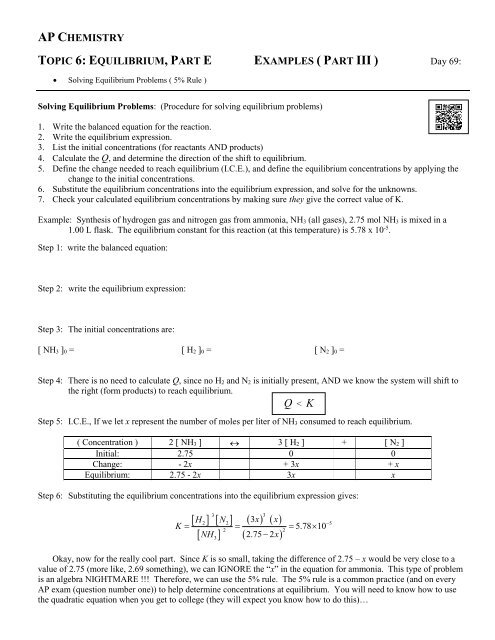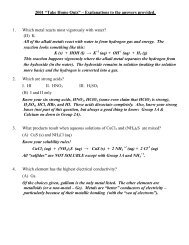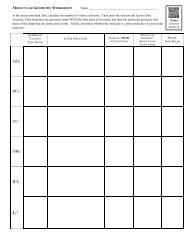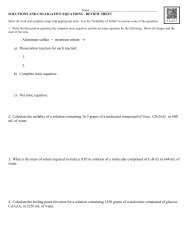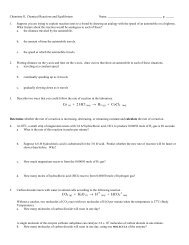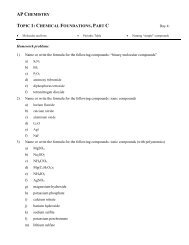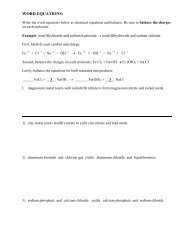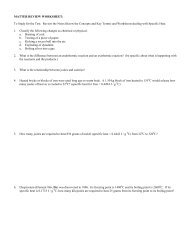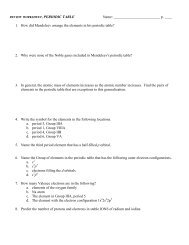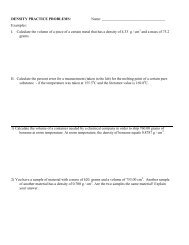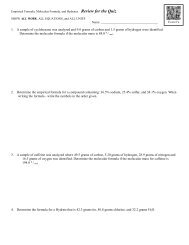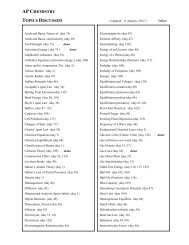Example Problems: (part III) - Avon Chemistry
Example Problems: (part III) - Avon Chemistry
Example Problems: (part III) - Avon Chemistry
Create successful ePaper yourself
Turn your PDF publications into a flip-book with our unique Google optimized e-Paper software.
AP CHEMISTRY<br />
TOPIC 6: EQUILIBRIUM, PART E EXAMPLES ( PART <strong>III</strong> ) Day 69:<br />
Solving Equilibrium <strong>Problems</strong> ( 5% Rule )<br />
Solving Equilibrium <strong>Problems</strong>: (Procedure for solving equilibrium problems)<br />
1. Write the balanced equation for the reaction.<br />
2. Write the equilibrium expression.<br />
3. List the initial concentrations (for reactants AND products)<br />
4. Calculate the Q, and determine the direction of the shift to equilibrium.<br />
5. Define the change needed to reach equilibrium (I.C.E.), and define the equilibrium concentrations by applying the<br />
change to the initial concentrations.<br />
6. Substitute the equilibrium concentrations into the equilibrium expression, and solve for the unknowns.<br />
7. Check your calculated equilibrium concentrations by making sure they give the correct value of K.<br />
<strong>Example</strong>: Synthesis of hydrogen gas and nitrogen gas from ammonia, NH 3 (all gases), 2.75 mol NH 3 is mixed in a<br />
1.00 L flask. The equilibrium constant for this reaction (at this temperature) is 5.78 x 10 -5 .<br />
Step 1: write the balanced equation:<br />
Step 2: write the equilibrium expression:<br />
Step 3: The initial concentrations are:<br />
[ NH 3 ] 0 = [ H 2 ] 0 = [ N 2 ] 0 =<br />
Step 4: There is no need to calculate Q, since no H 2 and N 2 is initially present, AND we know the system will shift to<br />
the right (form products) to reach equilibrium.<br />
Step 5: I.C.E., If we let x represent the number of moles per liter of NH 3 consumed to reach equilibrium.<br />
( Concentration ) 2 [ NH 3 ] 3 [ H 2 ] + [ N 2 ]<br />
Initial: 2.75 0 0<br />
Change: - 2x + 3x + x<br />
Equilibrium: 2.75 - 2x 3x x<br />
Step 6: Substituting the equilibrium concentrations into the equilibrium expression gives:<br />
3<br />
H<br />
N<br />
<br />
NH<br />
<br />
3<br />
3x x<br />
2.75 2x<br />
K 5.7810<br />
2 2 5<br />
2 2<br />
3<br />
Q < K<br />
Okay, now for the really cool <strong>part</strong>. Since K is so small, taking the difference of 2.75 – x would be very close to a<br />
value of 2.75 (more like, 2.69 something), we can IGNORE the “x” in the equation for ammonia. This type of problem<br />
is an algebra NIGHTMARE !!! Therefore, we can use the 5% rule. The 5% rule is a common practice (and on every<br />
AP exam (question number one)) to help determine concentrations at equilibrium. You will need to know how to use<br />
the quadratic equation when you get to college (they will expect you know how to do this)…
So now our equation looks like this:<br />
This makes the algebra a LOT EASIER…<br />
Let’s finish, and solve for “x”…<br />
3<br />
H<br />
N<br />
<br />
NH<br />
<br />
3<br />
3x x<br />
2.75<br />
K 5.78<br />
10<br />
2 2 5<br />
2 2<br />
3<br />
Then:<br />
Then:<br />
Then:<br />
Then:<br />
3<br />
<br />
2<br />
2.75<br />
4<br />
3x x<br />
5<br />
27x<br />
5.7810<br />
<br />
7.5625<br />
<br />
<br />
5.7810 7.5625 27x<br />
5 4<br />
<br />
5.7810 5<br />
7.5625<br />
27<br />
1.6189 10 x<br />
5 4<br />
x<br />
4<br />
4 5<br />
1.6189 10 x 0.0634<br />
Now let’s find the concentrations of each at equilibrium:<br />
H<br />
x ; N<br />
x ; <br />
Okay, let’s check for the rule of 5%:<br />
2<br />
3 3 0.0634 0.1902<br />
2<br />
0.0634<br />
NH3 2.75<br />
3<br />
H<br />
N<br />
<br />
NH<br />
<br />
x x<br />
<br />
<br />
<br />
3 3<br />
3 0.1902 0.0634<br />
K 5.768<br />
10<br />
2.75 2.75<br />
2 2 5<br />
2 2 2<br />
3<br />
5 5<br />
calculated true<br />
5.76810 5.7810<br />
% Error 100 100 0.208 %<br />
5<br />
true<br />
5.7810<br />
That my friend is well within the 5% rule !!! And, this method saved us a great deal of time trying to<br />
solve a very interesting algebra problem… However, this will NOT work for every equilibrium problem, but<br />
if you NOTICE a very small K value (usually at least to the negative three power ( 10 -3 )) you may use the 5%<br />
rule… If the K value is not very small, you may need to use the quadratic equation (see examples, <strong>part</strong> II from<br />
today).


